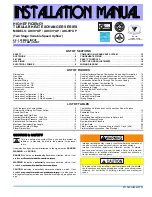
24
Checking Static Pressure
(80% Furnace Shown, 90% Similar)
F
ILTERS
- R
EAD
T
HIS
S
ECTION
B
EFORE
I
NSTALLING
T
HE
R
ETURN
A
IR
D
UCTWORK
Filters must be used with this furnace. Discuss filter mainte-
nance with the building owner. Filters do not ship with this
furnace, but must be provided by the installer. Filters must com-
ply with UL900 or CAN/ULCS111 standards. If the furnace is
installed without filters, the warranty will be voided.
NOTE:
An undersized opening will cause reduced airflow. The
bottom return is set up as a knock out.
U
PRIGHT
I
NSTALLATIONS
Depending on the installation and/or customer preference, dif-
fering filter arrangements can be applied. Filters can be in-
stalled in the central return register or a side panel external
filter rack kit (upflows), or the ductwork above a downflow fur-
nace. As an alternative, a media air filter or electronic air cleaner
can be used as the primary filter.
C
IRCULATION
A
IR
F
ILTERS
One of the most common causes of a problem in a forced air
heating system is a blocked or dirty filter. Circulating air filters
must be inspected monthly for dirt accumulation and replaced
if necessary. Failure to maintain clean filters can cause prema-
ture heat exchanger failure.
A new home may require more frequent replacement until all
construction dust and dirt is removed. Circulating air filters are
to be installed in the return air duct external to the furnace
cabinet.
FURNACE INPUT (BTU/hr)
FILTER SIZE
60K
610 in
2
80K
813 in
2
100K
889 in
2
DISPOSABLE NOMINAL 300 F.P.M. FACE VELOCITY
MINIMUM FILTER SIZES for DISPOSABLE FILTERS
H
ORIZONTAL
I
NSTALLATIONS
Filters must be installed in either the central return register or
in the return air duct work.
S
TART
-
UP
P
ROCEDURE
A
ND
A
DJUSTMENT
Furnace must have a 115 VAC power supply properly connected
and grounded. Proper polarity must be maintained for correct
operation. In addition to the following start-up and adjustment
items, refer to further information in
Operational Checks
sec-
tion.
H
EAT
A
NTICIPATOR
S
ETTING
The heat anticipator in the room thermostat must be correctly
adjusted to obtain the proper number of cycles per hour and to
prevent “overshooting” of the setting. Set the heat anticipator
setting to 0.7 amps. Follow the thermostat manufacturer’s
instructions on how to adjust the heat anticipator setting.
F
URNACE
O
PERATION
Purge gas lines of air prior to startup. Be sure not purge lines
into an enclosed burner compartment.
Check for leaks using an approved chloride-free soap and wa-
ter solution, an electronic combustible gas detector, or other
approved method. Verify that all required kits (propane gas,
high altitude, etc.) have been appropriately installed.
F
URNACE
S
TARTUP
1. Close the manual gas shutoff valve external to the furnace.
2. Turn off the electrical power to the furnace.
3. Set the room thermostat to the lowest possible setting.
4. Remove the burner compartment door.
NOTE:
This furnace is equipped with an ignition device which
automatically lights the burner. Do not try to light the burner by
hand.
5. Move the furnace gas valve manual control to the OFF
position.
6. Wait five minutes then smell for gas. Be sure check
near the floor as some types of gas are heavier than air.
7. If you smell gas after five minutes, immediately follow
the
Safety Instructions
on page 2 of this manual. If you
do not smell gas after five minutes, move the furnace
gas valve manual control to the ON position.
8. Replace the burner compartment door.
9. Open the manual gas shutoff valve external to the furnace.
10. Turn on the electrical power to the furnace.
11. Adjust the thermostat to a setting above room
temperature.












































